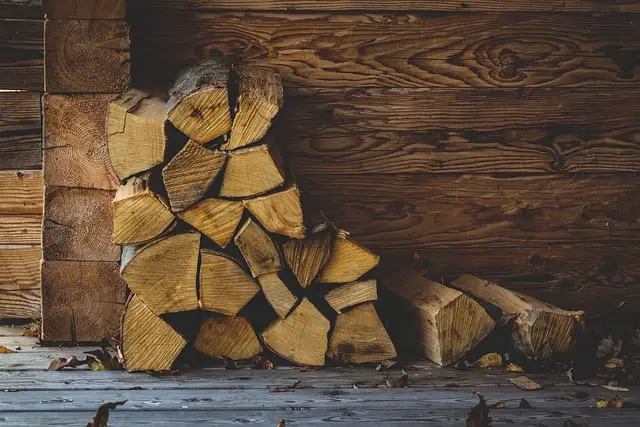Some woods can be considered less environmentally friendly to burn due to various factors beyond just their emissions. These factors include their scarcity, deforestation implications, habitat destruction, and the overall impact on the ecosystem.
Tropical hardwoods such as mahogany and teak run the risk of deforestation. Using woods from old-growth forests or rare tree species can contribute to habitat loss and reduce biodiversity. Additionally, burning woods sourced from endangered or overexploited species can further deplete their populations.
It is important to consider the sustainability and environmental impact of the wood source to minimize negative effects on ecosystems and promote responsible and ethical wood-burning practices.
Let’s take a closer look at which woods are considered the least environmentally friendly to burn and why.
Woods That Cause More Significant Environmental Concerns
It’s important to note that using any wood for burning will result in carbon emissions and should be done responsibly.
However, some woods may have more significant environmental concerns. Here are a few examples:
- Tropical hardwoods: Some tropical hardwoods, such as mahogany or teak, are known for their durability and high heat output. However, their use can contribute to deforestation and habitat loss in sensitive tropical regions.
- Softwoods treated with chemicals: Some softwoods, like pine or spruce, are commonly treated with chemicals to enhance their durability or resistance to pests. Burning these chemically treated woods can release harmful pollutants into the air.
- Old-growth or rare woods: Burning rare or old-growth woods, which may take many years or even centuries to regenerate, can have significant environmental consequences.
To minimize the environmental impact of burning wood, it is generally recommended to choose sustainably sourced and locally available woods. Look for certified sustainable wood products, such as those labeled with Forest Stewardship Council (FSC ) certification, which ensures responsible forestry practices.
) certification, which ensures responsible forestry practices.
Additionally, using wood from renewable sources, such as fruit trees or fast-growing species, can be a more environmentally friendly option.
Always follow local regulations, consider the availability of alternative fuel sources like propane or natural gas, and use efficient burning practices to minimize the environmental impact of using wood for heating or cooking purposes.

Reconciling Wood Burning With The Fact That Wood Is A Renewable Resource
The reconciliation of burning wood as a renewable resource involves considering the following factors:
- Sustainable Forestry Practices: It is crucial to ensure that the wood used for burning comes from sustainably managed forests. Sustainable forestry practices involve responsible tree harvesting, reforestation efforts, and protection of biodiversity.
By following these practices, the ecological balance of forests can be maintained, and the long-term sustainability of the resource can be ensured. - Carbon Neutrality: When wood is burned, the carbon dioxide released is part of the natural carbon cycle. As trees grow, they absorb carbon dioxide from the atmosphere and store it in their biomass. When the wood is burned, the stored carbon is released back into the atmosphere.
This process is considered carbon neutral because the carbon emitted from burning wood is balanced by the carbon absorbed during tree growth.
However, it is essential to use wood-burning appliances efficiently to minimize emissions. - Local Sourcing: Utilizing locally sourced wood reduces the environmental impact associated with transportation and supports local economies. Buying wood from trusted suppliers who adhere to sustainable forestry practices and certifications, such as Forest Stewardship Council (FSC), can provide assurance of responsible sourcing.
- Alternative Fuel Sources: While wood is a renewable resource, it is essential to consider alternative fuel sources when appropriate. In some cases, using renewable energy options like solar, wind, or biomass fuels generated from waste materials can further reduce the environmental impact associated with burning wood.
By combining responsible sourcing, sustainable forestry practices, efficient burning techniques, and consideration of alternative fuels, it is possible to reconcile the use of wood as a renewable resource with the goal of minimizing environmental impact.
It is crucial to strike a balance between utilizing renewable resources and employing sustainable practices to ensure a sustainable future.
Summary Of Woods To Never Burn
Here’s a table listing types of wood you should avoid burning due to noxious fumes and other concerns:
| Type of Wood | Reasons to Avoid |
|---|---|
| Poisonous Woods | Woods like poison oak, ivy, or sumac can release toxic fumes when burned. Avoid these at all costs. |
| Softwoods | Softwoods like pine, fir, and spruce contain high resin content, leading to excessive smoke and creosote buildup. |
| Chemically Treated Wood | Wood that’s been chemically treated or painted may release harmful chemicals when burned. |
| Wood with Mold or Fungus | Burning moldy or fungus-infested wood can release toxic spores and fumes. |
| Wood with Unknown Origin | If you don’t know the wood’s origin or it’s been exposed to contaminants, it’s safer to avoid using it for smoking. |
Always prioritize safety when selecting wood for smoking, and opt for well-seasoned, hardwoods known for their suitability in food preparation to ensure the best results.
Final Thoughts
Burning environmentally friendly woods is crucial for several reasons. Firstly, it helps to preserve natural resources by promoting sustainable forestry practices and minimizing deforestation. By choosing woods that are abundant and responsibly sourced, we can ensure the long-term availability of wood as a renewable resource.
Secondly, environmentally friendly woods contribute to maintaining ecological balance and biodiversity by avoiding the use of endangered or rare tree species.
Lastly, burning environmentally friendly woods reduces the overall environmental impact by minimizing emissions and promoting cleaner air quality. By making conscious choices in our wood-burning practices, we can contribute to a more sustainable and environmentally friendly approach to heating and cooking.
Now that we’ve discussed woods to avoid burning, let’s take a closer look at What Woods Are Most Environmentally Friendly To Burn?

